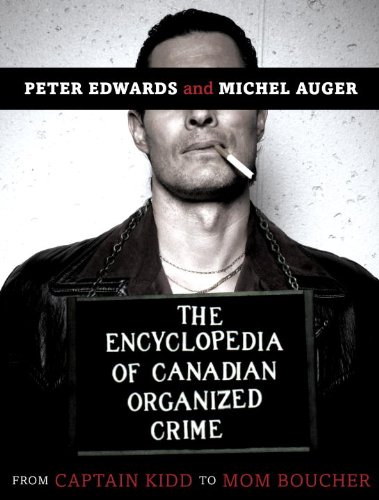The Encyclopedia of Canadian Organized Crime
 Buy the Book:
Buy the Book:Amazon
Published by: McClelland & Stewart
Release Date: July 31, 2012
Pages: 304
ISBN13: 978-0771030499
Overview
Respected crime reporters Peter Edwards and Michel Auger have pooled their research and expertise to create The Encyclopedia of Canadian Organized Crime. Sometimes grim, sometimes amusing, and always entertaining, this book is filled with 300 entries and more than 150 illustrations, covering centuries of organized crime. From pirates such as “Black Bart,” who sheltered in isolated Newfoundland coves to strike at the shipping lanes between Europe and the North American colonies, all the way to the most recent influx of Russian mobsters, who arrived after the end of the Cold War in 1989 and are now honing their sophisticated technological skills on the Western public, Edwards and Auger enumerate the personalities and the crimes that have kept Canadian law enforcement busy. Here too are the Sicilian and Calabrian gangs, the American and Colombian drug connections, the bikers whose internal struggles have left innocent bystanders dead (and who tried to murder Auger), as well as many unexpected figures, such as the Sundance Kid, who spent years in Canada.
Arranged in alphabetical entries for easy browsing, and illustrated throughout with photographs and drawings, this is a book that will both entertain and inform. The Encyclopedia of Canadian Organized Crime has remained in bookstores for more than a decade, with the authors offering updates as criminals and police continue to go about their work.
Praise
“With admirable diligence and dispatch, the authors harmonize the multiple solitudes that make up this vast nation into one fascinating, readable tome of transgression and terror.”
—The Globe and Mail
Excerpt
Organized crime is a slippery subject, involving slippery people, and evades an exact definition. In drawing up this list of organized criminals and groups, we have been strongly influenced by new anti-gang laws, which define a criminal organization as a group of three or more people whose main activities include committing crimes for some benefit. We realize that sometimes there’s a fine line between terrorism and organized crime, as with the attacks by the Hells Angels on the justice system in Quebec in the late 1990s and early 2000s. Other times, criminals are clearly habitual offenders, but it’s a generous stretch to call them organized. For the purposes of this book, we have largely focused on criminal activities in which profit was the main motive, as opposed to passion, perversion, mental illness, or politics. We were also interested in criminal activity that was ongoing and which involved planning. Finally, we looked for some specific code of conduct: one existed on the pirate ships of Peter Easton in the early seventeenth century and they can still be found today amongst modern-day biker gangs and Mafia groups.
Also, it should be clear that this is a book about crime and criminals, not ethnic groups. There’s diversity in crime as well as in mainstream Canadian life, and organized criminals make up just a minuscule fraction of any ethnic group mentioned here. For instance, crime analysts have estimated that 0.02 per cent of the Italian-heritage community is involved in Mafia activity in Canada.
We often wondered, Why do some criminals enjoy longevity, while others don’t? One common thread shared by the successful organized criminals described in these pages is a vital link to transportation routes. To be effective for any length of time, groups have to be able to move goods and people, whether they’re taking illegal drugs to market or moving themselves — speedily — out of harm’s way. Such access to transportation routes was standard amongst the seventeenth-century pirates of the Atlantic coast, the coureurs de bois of pre-Confederation, the bootlegging gangs that followed crews building the Canadian Pacific Railway, criminals like the Sundance Kid on the Outlaw Trail of southern Saskatchewan at the turn of the twentieth century, the bootleggers of Prohibition, and, today, the cocaine cartels and the Hells Angels, with their acute interest in the shipping ports of Vancouver, Montreal, and Halifax.
But perhaps the most important central thread connecting the groups described in these pages is control of officials — either through corruption or intimidation. They all need to compromise officials in ostensibly legitimate jobs in order to function for any length of time..